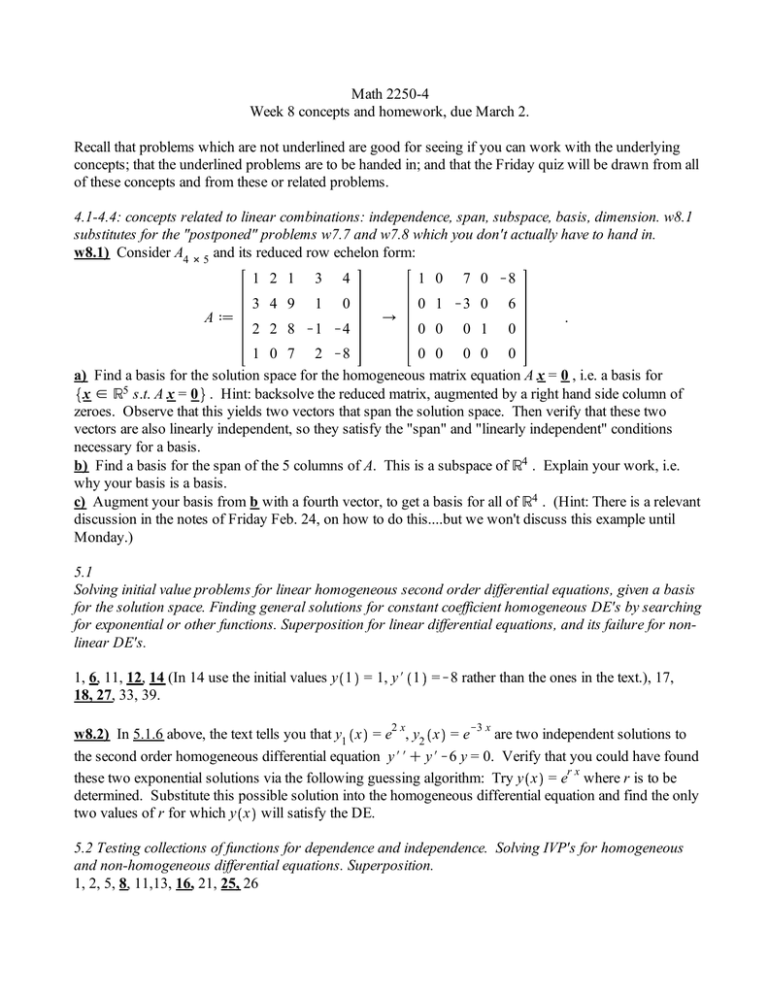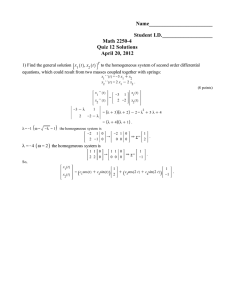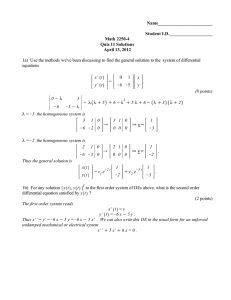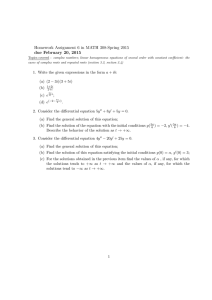Math 2250-4 Week 8 concepts and homework, due March 2.
advertisement

Math 2250-4 Week 8 concepts and homework, due March 2. Recall that problems which are not underlined are good for seeing if you can work with the underlying concepts; that the underlined problems are to be handed in; and that the Friday quiz will be drawn from all of these concepts and from these or related problems. 4.1-4.4: concepts related to linear combinations: independence, span, subspace, basis, dimension. w8.1 substitutes for the "postponed" problems w7.7 and w7.8 which you don't actually have to hand in. w8.1) Consider A4 # 5 and its reduced row echelon form: Ad 1 2 1 3 4 3 4 9 1 0 2 2 8 K1 K4 1 0 / 7 0 K8 0 1 K3 0 6 0 0 0 0 1 . 1 0 7 2 K8 0 0 0 0 0 a) Find a basis for the solution space for the homogeneous matrix equation A x = 0 , i.e. a basis for x 2 =5 s.t. A x = 0 . Hint: backsolve the reduced matrix, augmented by a right hand side column of zeroes. Observe that this yields two vectors that span the solution space. Then verify that these two vectors are also linearly independent, so they satisfy the "span" and "linearly independent" conditions necessary for a basis. b) Find a basis for the span of the 5 columns of A. This is a subspace of =4 . Explain your work, i.e. why your basis is a basis. c) Augment your basis from b with a fourth vector, to get a basis for all of =4 . (Hint: There is a relevant discussion in the notes of Friday Feb. 24, on how to do this....but we won't discuss this example until Monday.) 5.1 Solving initial value problems for linear homogeneous second order differential equations, given a basis for the solution space. Finding general solutions for constant coefficient homogeneous DE's by searching for exponential or other functions. Superposition for linear differential equations, and its failure for nonlinear DE's. 1, 6, 11, 12, 14 (In 14 use the initial values y 1 = 1, y# 1 =K8 rather than the ones in the text.), 17, 18, 27, 33, 39. w8.2) In 5.1.6 above, the text tells you that y1 x = e2 x, y2 x = eK3 x are two independent solutions to the second order homogeneous differential equation y##C y#K6 y = 0. Verify that you could have found these two exponential solutions via the following guessing algorithm: Try y x = er x where r is to be determined. Substitute this possible solution into the homogeneous differential equation and find the only two values of r for which y x will satisfy the DE. 5.2 Testing collections of functions for dependence and independence. Solving IVP's for homogeneous and non-homogeneous differential equations. Superposition. 1, 2, 5, 8, 11,13, 16, 21, 25, 26 Here's a problem that integrates many of the ideas from sections 5.1-5.2, and also ties in with chapter 4: w8.3) Consider the three functions p y1 x = sin 3x , y2 x = sin 3x K , y3 x = cos 3x . 6 a) Show that all three functions solve the differential equation y##C 9 y = 0 . b) The differential equation above is a second order linear homogeneous DE, so the solution space is 2Kdimensional. Thus the three functions y1 , y2 , y3 above must be linearly dependent. Find a linear dependency. (Hint: use a trigonometry addition angle formula.) c) Explicitly verify that every initial value problem y##C 9 y = 0 y 0 = b1 y# 0 = b2 has a solution of the form y x = c1 sin 3 x C c2 cos 3 x , and that c1 , c2 are uniquely determined by b1 , b2 . Use the existence-uniqueness theorem to explain why this proves that y1 x and y3 x are a basis for the solution space to y##C 9 y = 0 . d) Compute the Wronskian matrix for y1 x , y3 x . What does this matrix, evaluated at x = 0, have to do with the algebra related to c? What is the significance of the fact that the Wronskian (determinant) is nonzero at x = 0, in terms of knowing that c1 , c2 are uniquely determined by b1 , b2 ? e) Find by inspection, particular solutions y x to the two non-homogeneous differential equations y##C 9 y = 18, y##C 9 y =K9 x Hint: one of them could be a constant, the other could be a multiple of x . f) Use superposition and your work from c,e to find the general solution to the non-homogeneous differential equation y##C 9 y = 18 K 9 x . g) Solve the initial value problem y##C 9 y = 18 K 9 x y 0 =0 y# 0 = 0 .





